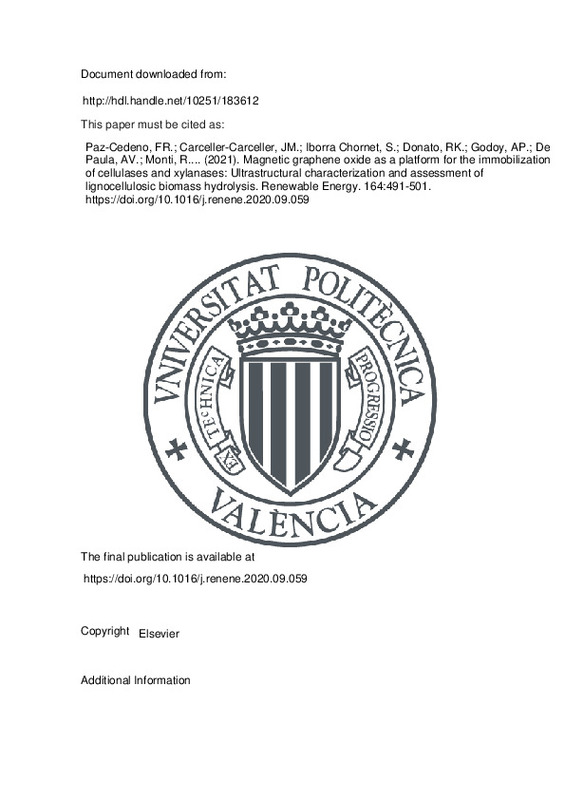Paz-Cedeno, FR.; Carceller-Carceller, JM.; Iborra Chornet, S.; Donato, RK.; Godoy, AP.; De Paula, AV.; Monti, R.... (2021). Magnetic graphene oxide as a platform for the immobilization of cellulases and xylanases: Ultrastructural characterization and assessment of lignocellulosic biomass hydrolysis. Renewable Energy. 164:491-501. https://doi.org/10.1016/j.renene.2020.09.059
Por favor, use este identificador para citar o enlazar este ítem: http://hdl.handle.net/10251/183612
|
Título:
|
Magnetic graphene oxide as a platform for the immobilization of cellulases and xylanases: Ultrastructural characterization and assessment of lignocellulosic biomass hydrolysis
|
|
Autor:
|
Paz-Cedeno, Fernando Roberto
 Carceller-Carceller, Jose Miguel
Carceller-Carceller, Jose Miguel

 Iborra Chornet, Sara
Donato, Ricardo Keitel
Godoy, Anna Paula
de Paula, Ariela Veloso
Monti, Rubens
Iborra Chornet, Sara
Donato, Ricardo Keitel
Godoy, Anna Paula
de Paula, Ariela Veloso
Monti, Rubens

 Corma Canós, Avelino
Masarin, Fernando
Corma Canós, Avelino
Masarin, Fernando
|
|
Entidad UPV:
|
Universitat Politècnica de València. Departamento de Química - Departament de Química
|
|
Fecha difusión:
|
|
|
Resumen:
|
[EN] For producing second-generation ethanol (cellulosic ethanol) and other value-added bioproducts, magnetic graphene oxide (GO-MNP) was synthesized in this work and used as the immobilization support for an industrial ...[+]
[EN] For producing second-generation ethanol (cellulosic ethanol) and other value-added bioproducts, magnetic graphene oxide (GO-MNP) was synthesized in this work and used as the immobilization support for an industrial cellulase-and xylanase-containing preparation. GO-MNP characterization by TEM, SEM and ATR-FTIR spectroscopy showed that the magnetic nanoparticles are homogeneously distributed onto the GO sheets surface. The enzymatic preparation was immobilized by means of carbodiimide cross-linking chemistry using 1-ethyl-3-(3-dimethylaminopropyl) carbodiimide and N-hydroxysuccinimide (NHS). The supported final biocatalyst (GO-MNP-Enz) showed high activity for the hydrolysis of pretreated sugarcane bagasse (PSB) and presented relative endoglucanase, xylanase, beta-glucosidase, and beta-xylosidase activities of 70%, 66%, 88%, and 70%, respectively, after 10 cycles of hydrolysis of their respective substrates. The biocatalyst also maintained approximately 50% and 80% of its efficiency for cellulose and xylan hydrolysis, respectively, being the TOF (g.g(-1).h(-1)) the highest observed when compared with previous results reported in literature. These findings suggest that GO-MNP-Enz may be a prospective candidate for industrial applications such as second-generation ethanol production. (C) 2020 Elsevier Ltd. All rights reserved.
[-]
|
|
Palabras clave:
|
Enzyme immobilization
,
Graphene oxide
,
Magnetic nanoparticles
,
Biocatalyst
,
Sugarcane bagasse hydrolysis
,
Monomeric fermentable sugars
|
|
Derechos de uso:
|
Reconocimiento - No comercial - Sin obra derivada (by-nc-nd)
|
|
Fuente:
|
Renewable Energy. (issn:
0960-1481
)
|
|
DOI:
|
10.1016/j.renene.2020.09.059
|
|
Editorial:
|
Elsevier
|
|
Versión del editor:
|
https://doi.org/10.1016/j.renene.2020.09.059
|
|
Código del Proyecto:
|
info:eu-repo/grantAgreement/AEI/Plan Estatal de Investigación Científica y Técnica y de Innovación 2017-2020/PGC2018-097277-B-I00/ES/MEJORA DEL CONCEPTO DE BIORREFINERIA MEDIANTE IMPLEMENTACION DE NUEVOS PROCESOS CATALITICOS CON CATALIZADORES SOLIDOS DE METALES NO NOBLES PARA LA PRODUCCION DE BIOCOMPUESTOS/
info:eu-repo/grantAgreement/FAPESP//2018%2F06241e3/
info:eu-repo/grantAgreement/MINISTERIO DE ECONOMÍA, INDUSTRIA Y COMPETITIVIDAD//SEV-2016-0683//Programa Estatal de Fomento de la Investigación Científica y Técnica de Excelencia/
|
|
Agradecimientos:
|
Sao Paulo State Research Support Foundation (FAPESP) contract number 2018/06241e3 funding this work. Coordination of Improvement of Higher Education Personnel (CAPES) funding the doctoral scholarship of Fernando Roberto ...[+]
Sao Paulo State Research Support Foundation (FAPESP) contract number 2018/06241e3 funding this work. Coordination of Improvement of Higher Education Personnel (CAPES) funding the doctoral scholarship of Fernando Roberto Paz-Cedeno in Brazil and in the Universitat Politecnica de Valencia (UPV), Institute of Chemical Technology (ITQ), Valencia, Spain. Authors acknowledge financial support from PGC2018-097277-B-100 (MCIU/AEI/FEDER,UE) project and Severo Ochoa Program (SEV-2016-0683).
[-]
|
|
Tipo:
|
Artículo
|







![[Cerrado]](/themes/UPV/images/candado.png)


